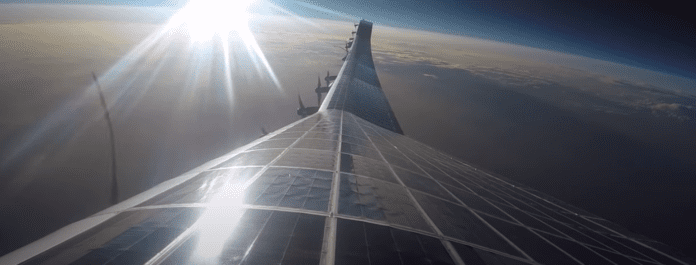A video call connected from the stratosphere topped off a recent test of an autonomous, fixed-wing aircraft, as Loon and HAPSMobile successfully put a telecommunications payload into the upper reaches of the atmosphere and used it to deliver LTE connectivity.
Video from the test shows the Sunglider, a slightly arched slice of solar panels, propellers and sleek vertical supports, taking off in darkness and gives glimpses of the vehicle as it climbs, clouds dotting the sky below. It also shows the Sunglider at height, where it spent 5 hours and 38 minutes at an altitude of 62,500 feet, with Earth’s horizon curving across the camera’s field of vision and the sun gleaming off the solar panels. While the silent video projects a calm view of the vehicle’s surrounds, Loon and HAPSMobile said that wind speeds at times reached more than 58 knots (about 30 meters per second) and temperatures were as low as -73 degrees Celsius (-25.6 degrees Fahrenheit).
HAPSMobile is a joint venture formed in late 2017 by SoftBank and California-based AeroVironment; SoftBank owns 95% of the company. The company has been an important partner for Loon since last year, when it put $125 million into Loon with an option to invest another $125 million on top of that, and solidified plans to collaborate on high-altitude network connectivity solutions.
HAPSMobile and Loon detailed the testing in a Medium post and said that the payload performed “as planned.” The test, they added, was the world’s first successful delivery of LTE connectivity from a fixed-wing High Altitude Platform Station (HAPS, sometimes also referred to as High-Altitude Pseudo Satellites) autonomous aircraft in the stratosphere. The system relied on the use of multiple-input multiple-output (MIMO) technology and 700 MHz spectrum as a service link from the Sunglider, and a feeder link in millimeter wave spectrum between the aircraft and a ground gateway, according to Loon and HAPSMobile. Because the service link used Band 48 spectrum, users on the ground from Loon and Aerovironment were able to connect with commercial smartphones for the video call.
Subscribe now to get the daily newsletter from RCR Wireless News

The companies said that in addition to the video call, they conducted “basic measurements of stratosphere-to-ground radio wave propagation data that will be used toward future contributions to the ITU Radiocommunication Sector (ITU-R) with a view to international standardization” and that they plan to work with the ITU, 3GPP, telecom providers and regulators to advance the use of HAPS.
Luminaries associated with both of the companies joined in the call, which connected people from four global locations: New Mexico, Tokyo, California and Washington, DC. This included Vint Cerf, often called one of the “fathers of the internet”, who is also VP and chief internet evangelist at Google (Alphabet is the parent company of Loon) and Jun Murai, who is known as the “father of the internet in Japan” and is also an external director for HAPSMobile as well as a professor at Keio University. Loon CEO Alistair Westgarth and a ground team at Spaceport America in New Mexico, where the aircraft took off and landed, were also on the video call.

Cerf, in a statement, called the September 21 test event a “milestone demonstration” and added, “This technology holds great promise for the future of connectivity, especially as part of efforts to expand internet access to places that don’t yet have it.”
“Using the stratosphere for the mobile Internet is going to be the next most innovative challenge, and it will add to the existing and achieved innovations of the Internet,” said Jun Murai, who added that “The result was a perfect success, making very strong impressions on everybody with high-resolution, smooth video and practically no latency, which made for exciting and natural conversations. HAPS technology is greatly needed by all of us for natural disaster recovery and Internet inclusion, which are key missions of the Internet today. The Internet is for everyone, everything and everywhere. Now we step forward to achieve this dream.”

